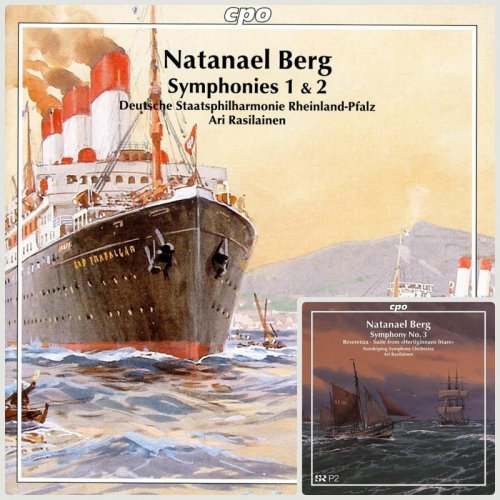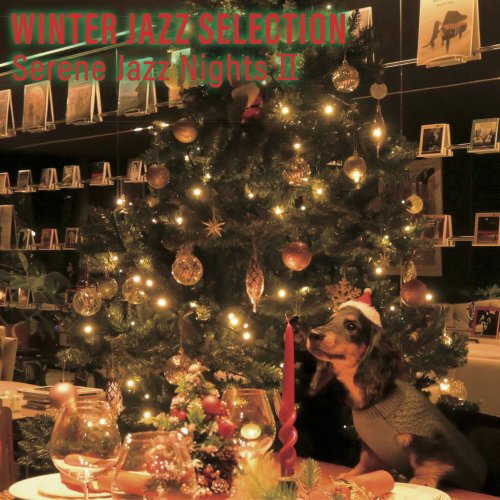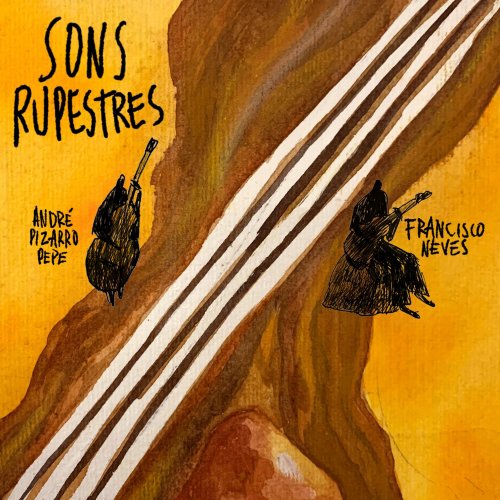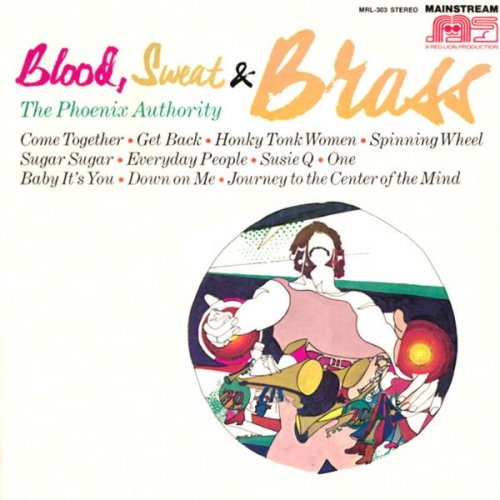Norrköping Symphony Orchestra, Ari Rasilainen - Natanael Berg: Symphony Nos. 1-3 (2009-2010)

Artist: Norrköping Symphony Orchestra, Ari Rasilainen
Title: Natanael Berg: Symphony Nos. 1-3
Year Of Release: 2009-2010
Label: CPO
Genre: Classical
Quality: flac lossless (tracks)
Total Time: 01:00:53 / 00:52:34
Total Size: 236 / 210 mb
WebSite: Album Preview
TracklistTitle: Natanael Berg: Symphony Nos. 1-3
Year Of Release: 2009-2010
Label: CPO
Genre: Classical
Quality: flac lossless (tracks)
Total Time: 01:00:53 / 00:52:34
Total Size: 236 / 210 mb
WebSite: Album Preview
Natanael Berg: Symphony Nos. 1 & 2
01. Symphony No. 1, "Alles endet was entstehet’": I. Allegro energico
02. Symphony No. 1, "Alles endet was entstehet’": II. Andante con moto
03. Symphony No. 1, "Alles endet was entstehet’": III. Presto
04. Symphony No. 1, "Alles endet was entstehet’": IV. Moderato molto
05. Symphony No. 2, "Arstiderna" (The Seasons): I. Printemps: Presto
06. Symphony No. 2, "Arstiderna" (The Seasons): II. Sommar: Allegro moderato
07. Symphony No. 2, "Arstiderna" (The Seasons): III. Automme: Lento grave
08. Symphony No. 2, "Arstiderna" (The Seasons): IV. Hiver: Lento
While the first two symphonies of Carl Natanael Berg are far from progressive works and have little historical significance (they were both composed rather loosely in a four-movement scheme that merely resembles symphonic form and were closer in style and spirit to late Romantic tone poems), they are still worth knowing about, for they elucidate the backward state of Swedish symphonic writing in the early decades of the twentieth century. This was a time when Brahms' symphonies were regarded as the last word on the subject, and Wagner's music was still regarded as too extreme, so it's small wonder that Berg's Symphony No. 1, "Alles endet was entstehet" (1914), and the Symphony No. 2, "Årstiderna" (1916), should be no more daring in form or musical content than the tone poems of Richard Strauss, which they most closely resemble. All the same, Berg's music is formally simplistic, developmentally limited, harmonically clichéd, and melodically shallow. Even in its most actively inventive and involved passages, as in the startling tone-painting of the sinking of the Titanic in the finale of the Symphony No. 1, or the colorfully orchestrated depictions of the seasons in the Symphony No. 2, everything seems contrived primarily for effect and barely connected to any true emotion or original conception. All the same, it is a good thing Ari Rasilainen and the Deutsche Staatsphilharmonie Rheinland-Pfalz have brilliantly performed and recorded these symphonies for CPO, because knowing of their flaws and inadequacies is still preferable to not knowing them at all. Although a major revival of Berg's music is unlikely to be fueled by this release, despite Rasilainen's advocacy and the orchestra's sterling playing, it is worth hearing this disc if only to gain a passing acquaintance with this obscure composer and his ultra-conservative milieu. CPO's sound is rich and spacious, so this is a sonic feast for the ears, even though the music provides little aesthetic sustenance.
Natanael Berg: Symphony No. 3
01. Reverenza
02. Hertiginnans friare (The Duchess's Suitor): I. Zigenardans
03. Hertiginnans friare (The Duchess's Suitor): II. Idyll och serenata
04. Hertiginnans friare (The Duchess's Suitor): III. Tarantella
05. Hertiginnans friare (The Duchess's Suitor): IV. Sevillana
06. Hertiginnans friare (The Duchess's Suitor): V. Polonais
07. Symphony No. 3, "Makter" (Forces): I. Mannen [Selbst ist der Mann]
08. Symphony No. 3, "Makter" (Forces): II. Kvinnan
CPO's project of recording the symphonies and other orchestral works of Swedish composer Carl Natanael Berg is admirable, insofar as this obscure music is better heard than left silent, moldering in a library somewhere. Yet no one should expect that this series is a great discovery, for Berg's music is quite conservative in outlook and derivative in the most naïve ways of Richard Strauss and other late Romantic composers of greater imagination. The Symphony No. 3, "Makter" (Forces, 1917), started out as a tone poem on the favorite symbolist subjects of Man and Woman, and the stereotypical portrayal of these genders as spiritual forces -- the male as the doomed warrior and the female as the quiet inner strength that proves victorious -- may seem a bit laughable today, especially as depicted in clichéd fanfares and empty drama. But this kind of music was taken seriously by the musical establishment of Sweden at the time, and even regarded as daring in some quarters. The Symphony No. 3 is only one in name, though, for there is little thematic development as found in the traditional symphonic form, and Berg's looseness with material and form suggests that his original idea of a tone poem was only slightly modified. The ballet suite Hertiginnans friare (The Suitors of the Duchess, 1921) and the celebratory Reverenza (1949), composed for the occasion of a conductor's birthday, are melodious and innocuous, but neither is a major work that would cause a revival of Berg's music. Ari Rasilainen and the Norrköping Symphony Orchestra play these works with commitment and obvious enjoyment, but that may be due more to feeling part of a cause in promoting Berg than to anything challenging or brilliant in the scores. This CD is valuable for documenting the works of an important figure in Swedish music, but the music itself is of limited interest.
![Paul Mauriat - L'avventura (1972) [Hi-Res] Paul Mauriat - L'avventura (1972) [Hi-Res]](https://img.israbox.com/img/2025-12/19/q8l5an3pdrx7j3uta0q4cr2qi.jpg)
![Clifton Chenier - The King of Zydeco (Live) (1981) [Hi-Res] Clifton Chenier - The King of Zydeco (Live) (1981) [Hi-Res]](https://img.israbox.com/img/2025-12/20/xjfs68k4k2e6nw8a1vz89ft6c.jpg)


![Cornelius Claudio Kreusch - Scoop (2025) [Hi-Res] Cornelius Claudio Kreusch - Scoop (2025) [Hi-Res]](https://www.dibpic.com/uploads/posts/2025-12/1765893706_folder.jpg)

![Betty Carter - The Music Never Stops (2019) [Hi-Res] Betty Carter - The Music Never Stops (2019) [Hi-Res]](https://www.dibpic.com/uploads/posts/2025-12/1765896843_bcmn500.jpg)
![Noé Sécula - A Sphere Between Other Obsessions (2025) [Hi-Res] Noé Sécula - A Sphere Between Other Obsessions (2025) [Hi-Res]](https://www.dibpic.com/uploads/posts/2025-12/1766108017_sej880ryk23va_600.jpg)
![The Mood Mosaic - The Sexploitation (Pulp Grooves From The Mondo Porno Vault) (2025) [Hi-Res] The Mood Mosaic - The Sexploitation (Pulp Grooves From The Mondo Porno Vault) (2025) [Hi-Res]](https://www.dibpic.com/uploads/posts/2025-12/1766131648_uhod8d4qn4msi_600.jpg)